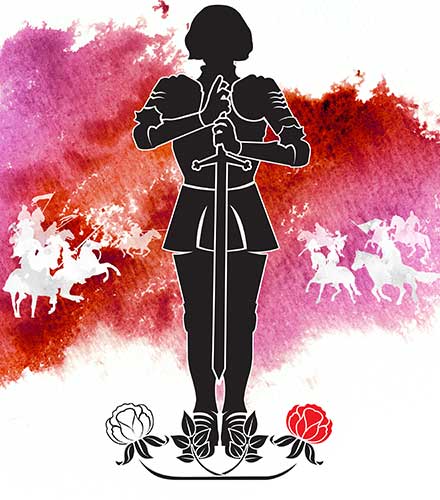Joan of Arc: A Hero or a Villian?

By Kathryn Neves
Most people know that Shakespeare wasn’t always overly concerned with historical accuracy. In fact, he was the king of taking artistic liberties. And there’s no better example of that than his treatment of Joan of Arc, featured in this season’s Henry VI Part One. The Maid of Orléans— France’s greatest hero— is one of Shakespeare’s most notorious and fascinating villains.
What can we say about Joan of Arc that hasn’t already been said? The French revered her as a heroine and a savior for centuries, and she was beatified by the Catholic Church in the early 1900s. Her near-miraculous military maneuvers and her extreme religious devotion paint a clear picture in the history textbooks. But not everyone loved her. Was she a war hero, gifted with political brilliance? Was she a saint, receiving visions from God and performing miracles? Or was she an evil criminal, using the religious piety of those around her to manipulate and use them? The English (and, thus, Shakespeare) certainly seemed to think the latter. When Joan was finally caught, her captors were “more joyous than if [they] had captured a king.” (quoted in Larissa Juliet Taylor, “Joan of Arc, the Church, and the Papacy, 1429–1920,” the Catholic Historical Review 98, no. 2 [April 2012]: 224). Shakespeare’s Joan of Arc is everything that the English hated about the real historical figure. So how different is Shakespeare’s Joan from the real maiden warrior?
Well, Shakespeare didn’t make everything up. There are several things about La Pucelle, as the Bard called her, that are true to life. A lot happens in the play that needs no Shakespearean embellishment. The first time we see Joan in Henry VI Part One, she has arrived in the court of Charles, the French dauphin. Without being told, she is able to identify the real Charles rather than the man they’d put in his place; “I know thee well,” she tells him, “though never seen before. / Be not amazed; there’s nothing hid from me” (1.2.68–69). This really happened; it’s well documented that when Joan first arrived in the court of Charles, she pointed the Dauphin out of the crowd though she’d never seen him before, to the amazement of everyone there (though in reality, Joan had met Charles a few days earlier; her dramatic introduction to the French Court was staged by the dauphin) (Larissa Juliet Taylor, The Virgin Warrior: The Life and Death of Joan of Arc [New Haven: Yale University Press, 2009]), 41).
This isn’t the only thing that Shakespeare preserved from history. Throughout his play, the English lords and soldiers consistently slander Joan, calling her words that should never be used in polite company. Lord Talbot calls her “puzel” rather than Pucelle; “puzel” being an old English term for a promiscuous woman. Historically, the English hurled insults at Joan quite often. In responding to Joan’s threats, the English sent multiple letters implying that Joan’s virtue was not as pure as she claimed— statements that enraged the Maid of Orléans.
Other things, too, are fairly accurate— the idea of the French side worshipping Joan as someone sent from God was certainly true, as well as her great rescue of Orléans and her loss in Paris. Shakespeare even alludes to her craftiness and the ways that she manipulated words; something that the real Joan was reported to have done throughout her whole life— especially at the trial just before her execution (Taylor, The Virgin Warrior, 136–37). But it’s Shakespeare’s embellishments of Joan of Arc that show just how much the English despised her.
One of the first differences between Shakespeare’s villainess and the real-life warrior is the way that Charles reacts to her as a person. In Henry VI Part One, Charles is immediately enamoured with her; he finds her beautiful and enchanting: “My heart and hands thou hast at once subdued. . . . Let me thy servant and not sovereign be” (1.2.111–113). Charles quickly begins to revere Joan as a religious figure, asking her how he might worship her. This is greatly different from the real history behind Joan of Arc. In truth, Charles cared very little for Joan at the beginning, and even throughout her entire campaign. He believed, initially, that even meeting with Joan would tarnish his image and make him look foolish. He even made fun of Joan behind her back, as recorded by multiple sources (Taylor, The Virgin Warrior, 42). Charles didn’t even want Joan to be truly involved in the war; even after he had accepted her and allowed her to join the army, Charles intended Joan to be nothing more than a figurehead. He and his counselors believed that if the French army had someone holy to look up to, that morale would be raised and they might be able to lift the siege at the city of Orléans (Taylor, The Virgin Warrior, 47). But Shakespeare’s Charles immediately puts his trust in Joan and sends her into battle at once.
Another stark difference between the play and history is Joan’s interactions with the Duke of Burgundy. This duke, called Philip the Good, was an interesting figure within the war. He had a strong claim to the French throne and was one of Charles’s fiercest competitors for the crown. Throughout the war he fought on the English side. Charles, after being officially crowned Charles VII of France, tried to negotiate a peace with the duke in order to avoid more French bloodshed. Joan, however, was enraged; she wanted to go after Burgundy and his followers to prove Charles’s superiority as the true French king. Joan, it appears, was a highly determined warrior; never wanting to negotiate or be cautious, she instead preferred to march straight into battle without any doubt or hesitation (Taylor, The Virgin Warrior, 98). But in Henry VI Part One, it is Joan who reaches out to Burgundy. It is Joan who seeks for peace with Burgundy and asks for his help in the war against the English. Joan’s clever words and use of logic is what eventually persuades Burgundy to change sides and take up arms against the English. Shakespeare’s Joan is more of a political maneuverer than a general— wildly different from her historical counterpart.
Perhaps the most telling difference in Joan’s character can be found toward the end of the play. Beginning in Act 5, Joan becomes everything that the English have accused her of. She begins to conjure devils and evil spirits to help her in her battle against the English. She behaves disdainfully toward her father and her upbringing, and she claims a pregnancy in order to avoid burning at the stake. In history, Joan did none of these things. According to sources from witnesses at her trial and her execution, Joan never wavered in her religious devotion; she was able to astound the theologians present at her trial with her eloquent and knowledgeable answers (Taylor, The Virgin Warrior, 137), and she spent her dying breath crying out to God and Mary. Not only that, but Joan never acted ashamed of her upbringing. Late in Joan’s military career Charles officially named Joan and her family members to the nobility; however, Joan gave no indication that she cared, and she never tried to use it to her advantage (though many members of her family did) (Taylor, The Virgin Warrior, 108). And most of all, Joan never wavered in her claim of virginity; that was one of the defining aspects of her identity, and even when threatened with death Joan never claimed anything to the contrary. This is something in Shakespeare’s play that galls many of Joan’s modern-day fans; in the play, to escape execution, Joan claims she is pregnant and lists a number of men as possible fathers of her unborn child.
Why is it that Shakespeare treats Joan of Arc with such disdain throughout his play? After all, his depictions of the other French leaders are fair. And most of Shakespeare’s other villains have wide complexities behind their evil behavior. Why is it that Joan stands alone as a two-dimensional villain?
It wasn’t just because she was French. After all, centuries had passed by the time Shakespeare wrote this play; because the War of the Roses was so distant, there weren’t too many reasons for him to drag Joan through the mud. Politically, the English weren’t actively fighting the French in Shakespeare’s day. Instead, the reason for Shakespeare’s portrayal can be explained in one word: religion.
Queen Elizabeth I’s father, Henry VIII, was the spearhead of the Protestant Reformation. It was because of him that England went from being a Catholic country to one entirely Protestant. From the time of Henry VIII’s reign to Elizabeth’s, there was a lot of contention between Catholics and Protestants in England. And after Elizabeth took the throne, the country was supposed to be completely Protestant. It makes sense, therefore, that Shakespeare would slander a Catholic hero like Joan of Arc; by calling her a heretic and an evil witch, Shakespeare was proclaiming his own Protestantism and creating propaganda for the anti-Catholic government.
The real Joan of Arc was a complicated person; intensely brilliant and courageous, impulsive and dangerous, her actions rescued France from the hands of the English. Shakespeare’s vilification of the woman shows us very clearly how the English felt about the French and about Catholics during the time period. And however inaccurate Shakespeare’s Joan may have been, the character makes for an exciting and fascinating villain; with her, the play becomes an exciting play about war, power, and good versus evil.









